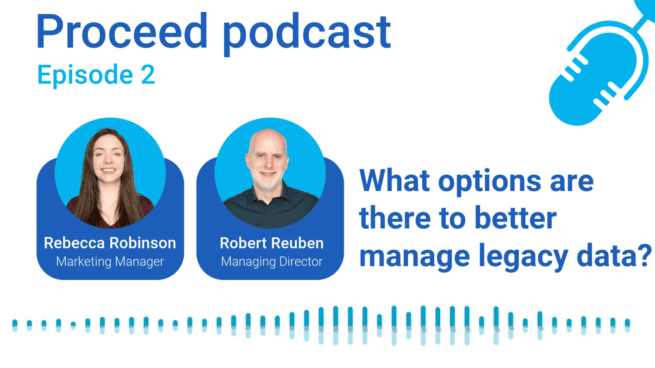
Options to better manage legacy data
In an episode of the Proceed podcast, we had the pleasure of sitting down with Proceed’s Managing Director, Robert Reuben, to discuss strategies for improved legacy data management. You can enjoy the entire episode by watching the video above or review the key highlights below.
The legacy data landscape
Legacy data management has become an increasing concern in the digital age. As businesses evolve and technology advances, the question of how to navigate legacy or read-only systems.
Robert pointed out that legacy systems, though outdated, persist for a multitude of reasons. They primarily serve as repositories for historical data. This data is often retained for historical business purposes, legal obligations, audits, or to comply with industry regulations. However, the challenge arises when businesses accumulate a multitude of legacy systems due to digital transformation, mergers, acquisitions, or the need to preserve specific data.
Challenges and risks of legacy systems
To effectively manage legacy data, it’s crucial to understand the challenges and risks involved. Robert highlighted some of the most pressing concerns:
- Legacy systems demand substantial financial resources for maintenance and upkeep.
- These systems run on outdated technology, making them vulnerable and less efficient.
- Older systems may lack robust security measures, leaving them exposed to potential threats.
- Staying audit-compliant
Industries and legacy data
While the need for legacy data management is universal, certain industries face more stringent data retention requirements. Pharmaceuticals and aviation, for instance, must retain data for extended periods due to strict regulations. Nonetheless, legacy systems are prevalent across various sectors, underscoring the broad-reaching importance of this issue.
Legacy data management solutions
The conversation with Robert also touched upon solutions to better manage legacy data. These include:
- Virtualisation to extend the life of legacy systems.
- Archiving reports
- System decommissioning, specialised legacy data management tools include, SAP ILM, widely used , offering storing and reporting capabilities or Proceed Cella, developed in-house, to complements SAP ILM, offering a, cloud-ready solution with a user-friendly interface.
Key steps to success
Robert emphasised that effective legacy data management is not just about technical implementation. It requires collaboration with stakeholders who comprehend data requirements, legal considerations, and business needs. The journey to successful legacy data management involves a balance between technical skils and expertise in defining data requirements – from extraction to user acceptance testing.
The key to a successful legacy data management project is balancing technical implementation with the expertise to define data needs.
Robert Reuben, Managing Director of Proceed Group
Further reading
[Case study] Dutch Rail – Driving digital transformation
[On-demand webinar] Are your legacy systems weighing down your transformation strategy?
[Video] Legacy system decommissioning
You may be interested in

Free SAP data archiving report
Proceed Group’s free SAP data archiving report analyses your ECC or S/4HANA data in minutes and pinpoints savings, performance boosts and compliance gaps before you migrate to RISE or the cloud.
Read more

SAP ECC archiving – Customer story
To keep SAP ECC and operations running smoothly, a global food business archived 14TB of legacy data and moved attachments to a content server. The result was a leaner 11TB database and a stronger foundation for future growth.
Read more

SAP decommissioning and its role in modern IT strategy
Stopping legacy SAP systems is easier said than done. This article shows why SAP decommissioning deserves a place in every transformation roadmap, what a successful project looks like and how to secure buy-in from finance, IT and compliance teams.
Read more

